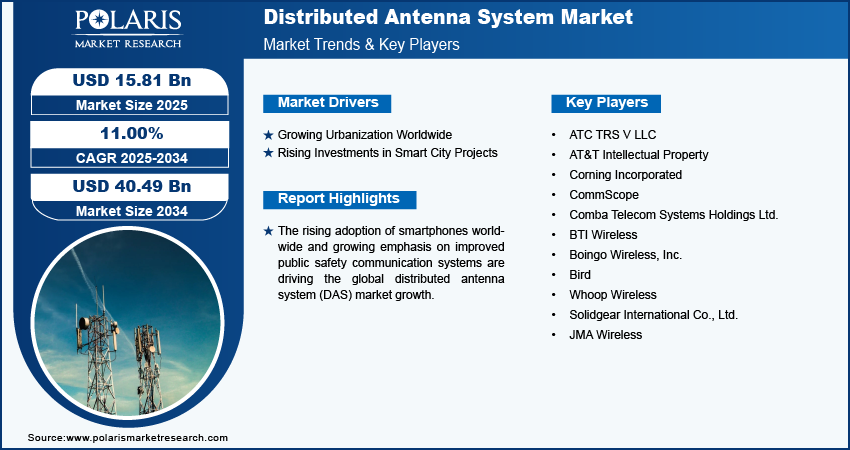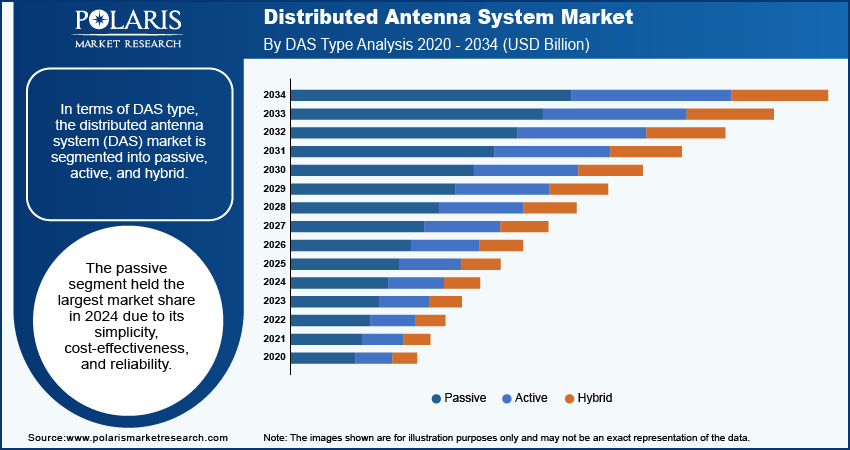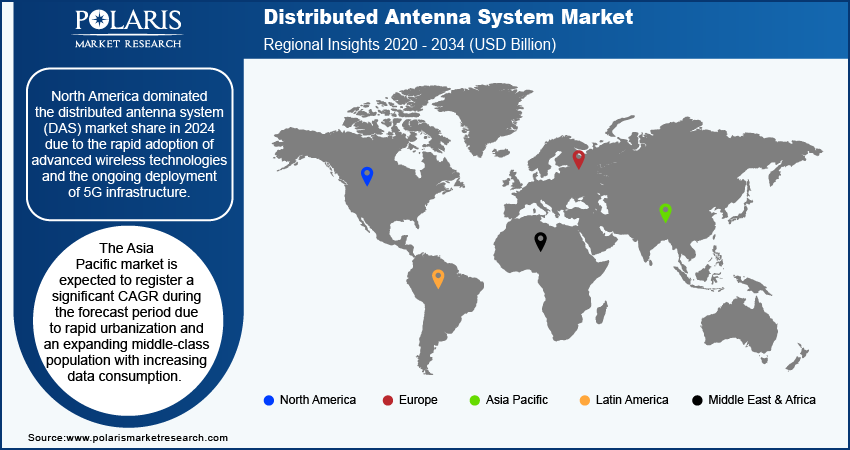
Distributed Antenna System (DAS) Market Size, Share, Trends, Industry Analysis Report: By Offering (Hardware and Services), DAS Type, Coverage, Ownership, Technology, User Facility, Vertical, and Region (North America, Europe, Asia Pacific, Latin America, and Middle East & Africa) – Market Forecast, 2025–2034
- Published Date:Nov-2024
- Pages: 122
- Format: PDF
- Report ID: PM2382
- Base Year: 2024
- Historical Data: 2020-2023
Distributed Antenna System (DAS) Market Overview
The distributed antenna system market size was valued at USD 14.28 billion in 2024. The market is projected to grow from USD 15.81 billion in 2025 to USD 40.49 billion by 2034, exhibiting a CAGR of 11.00% during 2025–2034.
Distributed antenna system (DAS) is a sophisticated network designed to improve wireless communication coverage and capacity, particularly in environments where traditional cellular networks struggle to provide adequate service. This technology addresses the limitations of conventional cell towers by deploying multiple smaller antennas throughout a designated area, such as large buildings, stadiums, airports, and other high-density locations. The core objective of DAS is to enhance signal strength and quality by strategically distributing the coverage area, thereby ensuring seamless connectivity for users.
The rising adoption of smartphones worldwide is driving the global distributed antenna system market growth. According to the GSMA’s annual State of Mobile Internet Connectivity Report 2023, over half (54%) of the global population (i.e., 4.3 billion people) owns a smartphone. Smartphones drive a massive increase in data consumption due to activities such as streaming, gaming, and social media. DAS helps manage this higher data traffic by improving network capacity and coverage, thereby increasing demand.
-market.webp)
The growing emphasis on improved public safety communication systems drives the distributed antenna system (DAS) market growth. Strong and consistent signal strength is vital in critical or emergency situations. DAS provides the necessary amplification of signals, especially in areas with challenging architecture or materials that block signals, such as concrete or metal, which increases their adoption and integration into existing communication systems to enhance public safety.
Distributed Antenna System Market Driver Analysis
Growing Urbanization Worldwide
The growing urbanization worldwide propels the growth of global DAS market. According to data published by the United Nations, more than half of the global population lives in urban areas. Urban areas generally have skyscrapers and multi-story buildings that obstruct signals from traditional cell towers. This spurs the demand for DAS as it distributes signals effectively throughout these structures, ensuring consistent coverage for occupants. Furthermore, urbanization leads to expanded public transportation networks, which increases the adoption of DAS as it improves connectivity in subway systems, trains, and buses, ensuring that passengers have access to reliable service while traveling.
Rising Investments in Smart City Projects
The rising investments in smart city projects fuel the global distributed antenna system market growth. The government of India released ₹48,000 crores (USD 5,782 million) to develop 100 smart cities across the country under the Smart City Mission (SCM). Smart cities rely on a wide range of interconnected devices and systems, including IoT sensors, traffic management systems, and public safety communications, which necessitates the use of DAS for faster connectivity required for these technologies to function effectively. Furthermore, many smart city projects are aligned with the rollout of 5G technology, which offers high speeds and low latency. DAS is essential for the deployment of 5G networks, facilitating better connectivity in smart cities.

Distributed Antenna System Market Segment Insights
DAS Market Breakdown by Ownership Insights
Based on ownership, the distributed antenna system market is segmented into neutral host, carrier, and enterprise. The neutral host segment accounted for a major market share in 2024 due to its ability to provide versatile solutions that cater to multiple service providers simultaneously. This model allows various carriers to share infrastructure, significantly reducing deployment costs and enhancing network efficiency. The rise of smart city initiatives and the ongoing deployment of 5G technology further accelerate this segment's growth as municipalities and enterprises seek to ensure seamless connectivity for residents and businesses alike. The collaboration between various telecom operators through neutral host models facilitates better coverage and reliability, making it an attractive option for businesses.
The carrier segment is projected to grow at a rapid pace during the forecast period owing to the rising need for individual operators to maintain control over their networks while meeting the increasing demand for mobile data. Carriers invest in dedicated systems to enhance their service quality and ensure robust connectivity, especially in densely populated areas and high-traffic venues. The expansion of 5G networks also propels this segment forward as carriers provide superior speed and reliability to compete in crowded areas. Furthermore, the growing prevalence of IoT devices is propelling the growth of the carrier segment.
Distributed Antenna System Market Breakdown by DAS Type Insights
In terms of DAS type, the distributed antenna system (DAS) market is segmented into passive, active, and hybrid. The passive segment held the largest market share in 2024 due to its simplicity, cost-effectiveness, and reliability. Passive systems use coaxial cables and antennas without the need for additional electronic equipment, making them easier to install and maintain. Many organizations, particularly in commercial buildings and venues, prefer passive systems as they require less infrastructure investment while providing adequate coverage in various environments. The demand for enhanced wireless connectivity in densely populated areas, combined with the need for efficient signal distribution, drives the adoption of passive systems.
The hybrid segment is estimated to grow at a robust pace in the coming years owing to its ability to offer advantages of passive and active systems. Hybrid solutions incorporate passive components, such as antennas and coaxial cables, and active elements, including remote radio units, providing flexibility and scalability. This configuration enables organizations to optimize coverage and performance, addressing the increasing data demands driven by smartphones, IoT devices, and the rollout of 5G networks. Additionally, hybrid systems are becoming increasingly attractive as enterprises and municipalities seek advanced solutions to enhance connectivity in complex environments.

Distributed Antenna System Market Regional Insights
By region, the study provides the DAS market insights into North America, Europe, Asia Pacific, Latin America, and the Middle East & Africa. North America dominated the market share in 2024 due to the rapid adoption of advanced wireless technologies and the ongoing deployment of 5G infrastructure. The presence of an established telecommunications framework in the region supports the high demand for DAS across various sectors, including healthcare, education, and entertainment. The existence of major telecom operators and technology companies fuels innovation and investments in DAS network solutions, leading to enhanced coverage and performance in both urban and rural areas. The US emerged as the dominant country in the regional market owing to its strong economy, high smartphone penetration, and significant funding for smart city initiatives.

The Asia Pacific distributed antenna system market is expected to record a significant CAGR during the forecast period due to rapid urbanization and a surging middle-class population with increasing data consumption. Countries such as China and India are at the forefront of this growth, as they invest heavily in telecommunications infrastructure to support their rising populations and urban centers. The growth of IoT devices and the demand for seamless connectivity in densely populated cities further accelerate the need for effective network solutions such as DAS. Additionally, government initiatives promoting digital transformation and smart city development create a favorable environment for the adoption of advanced communication systems in the region.
Distributed Antenna System Market – Key Players and Competitive Insights
Major market players are investing heavily in research and development to expand their offerings, which will help the DAS market grow even more. Market participants are also undertaking a variety of strategic activities to expand their global footprint, with important market developments such as innovative launches, international collaborations, higher investments, and mergers and acquisitions between organizations.
The distributed antenna system market is fragmented, with the presence of numerous global and regional market players. A few major players in the market are ATC TRS V LLC; AT&T Intellectual Property; Corning Incorporated; CommScope; Comba Telecom Systems Holdings Ltd.; BTI Wireless; Boingo Wireless, Inc.; Bird; Whoop Wireless; Solidgear International Co., Ltd.; Toshiba Infrastructure Systems & Solutions Corporation; and JMA Wireless.
Solidgear International Co., Ltd. is a prominent player in the telecommunications industry, specializing in advanced solutions such as distributed antenna systems (DAS). Its DAS system allows for the distribution of wireless signals across a designated area, effectively overcoming the limitations associated with single high-power antennas. DAS technology is essential for enhancing wireless communication in environments, including high-density urban areas, large buildings, and venues such as stadiums and airports, where traditional cellular networks face challenges.
Toshiba Infrastructure Systems & Solutions Corporation is a key innovator in the field of telecommunications, particularly known for its advancements in distributed antenna systems (DAS). Recently, Toshiba introduced the ART3711, a 5G shared DAS designed specifically for neutral host environments. This system operates within the 3.6-4.0 GHz frequency band and utilizes advanced time division duplexing (TDD) technology, allowing multiple mobile network operators (MNOs) to share the same infrastructure. This capability optimizes resource utilization and accelerates the deployment of extensive 5G networks, especially in densely populated urban areas such as Tokyo, where maintaining robust wireless connectivity is essential.
Key Companies in Distributed Antenna System Market
- ATC TRS V LLC
- AT&T Intellectual Property
- Corning Incorporated
- CommScope
- Comba Telecom Systems Holdings Ltd.
- BTI Wireless
- Boingo Wireless, Inc.
- Bird
- Whoop Wireless
- Solidgear International Co., Ltd.
- Toshiba Infrastructure Systems & Solutions Corporation
- JMA Wireless
Distributed Antenna System (DAS) Industry Developments
May 2024: SOLiD, a global player in cellular in-building mobile coverage, announced that systems integrator Wireless Services selected the SOLiD ALLIANCE 5G distributed antenna system (DAS) to enhance 5G connectivity in the New Orleans Ernest N. Morial Convention Center (NOENMCC).
January 2024: Toshiba Infrastructure Systems & Solutions Corporation, an innovator in technologies that support cellular telecoms, introduced ART3711, a new 5G distributed antenna system for neutral hosts.
March 2024: AT&T, a global telecommunications company that provides a range of services, introduced AT&T Internet Air for business that delivers reliable internet for a low price.
Distributed Antenna System Market Segmentation
By Offering Outlook (Revenue, USD Billion, 2020–2034)
- Hardware
- Services
By DAS Type Outlook (Revenue, USD Billion, 2020–2034)
- Passive
- Active
- Hybrid
By Coverage Outlook (Revenue, USD Billion, 2020–2034)
- Indoor
- Outdoor
By Ownership Outlook (Revenue, USD Billion, 2020–2034)
- Neutral Host
- Carrier
- Enterprise
By Technology Outlook (Revenue, USD Billion, 2020–2034)
- Carrier Wi-Fi
- Small Cells
By User Facility Outlook (Revenue, USD Billion, 2020–2034)
- >500K FT2
- 200K–500K FT2
- <200K FT2
By Vertical Outlook (Revenue, USD Billion, 2020–2034)
- Commercial
- Public Safety
By Regional Outlook (Revenue, USD Billion, 2020–2034)
- North America
- US
- Canada
- Europe
- Germany
- France
- UK
- Italy
- Spain
- Netherlands
- Russia
- Rest of Europe
- Asia Pacific
- China
- Japan
- India
- Malaysia
- South Korea
- Indonesia
- Australia
- Rest of Asia Pacific
- Middle East & Africa
- Saudi Arabia
- UAE
- Israel
- South Africa
- Rest of Middle East & Africa
- Latin America
- Mexico
- Brazil
- Argentina
- Rest of Latin America
Distributed Antenna System Market Report Scope
|
Report Attributes |
Details |
|
Market Size Value in 2024 |
USD 14.28 Billion |
|
Market Size Value in 2025 |
USD 15.81 Billion |
|
Revenue Forecast by 2034 |
USD 40.49 Billion |
|
CAGR |
11.00% from 2025 to 2034 |
|
Base Year |
2024 |
|
Historical Data |
2020–2023 |
|
Forecast Period |
2025–2034 |
|
Quantitative Units |
Revenue in USD Billion and CAGR from 2025 to 2034 |
|
Report Coverage |
Revenue Forecast, Market Competitive Landscape, Growth Factors, and Trends |
|
.Segments Covered |
|
|
Regional Scope |
|
|
Competitive Landscape |
|
|
Report Format |
|
|
Customization |
Report customization as per your requirements with respect to countries, regions, and segmentation. |
FAQ's
The global distributed antenna system market size was valued at USD 14.28 billion in 2024 and is projected to grow to USD 40.49 billion by 2034.
The global market is projected to register a CAGR of 11.00% during the forecast period.
North America accounted for the largest share of the global market in 2024.
A few key players in the market are ATC TRS V LLC; AT&T Intellectual Property; Corning Incorporated; CommScope; Comba Telecom Systems Holdings Ltd.; BTI Wireless; Boingo Wireless, Inc.; Bird; Whoop Wireless; Solidgear International Co., Ltd.; Toshiba Infrastructure Systems & Solutions Corporation; and JMA Wireless.
The hybrid segment is projected for significant growth in the global market during the forecast period.
The neutral host segment dominated the market in 2024.
